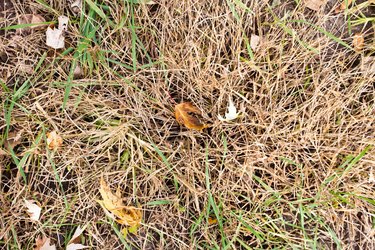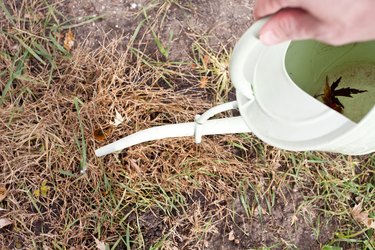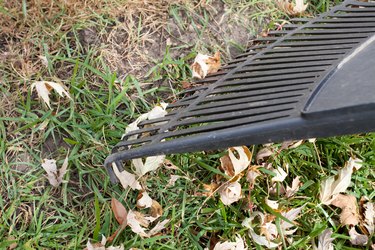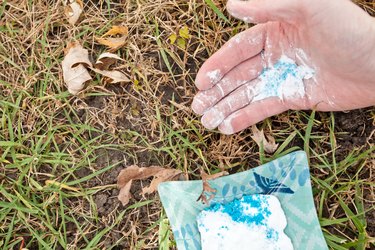
Red thread fungus mostly affects lawns in spring and early summer, because it thrives in cool, damp weather. The lawn develops tan patches where red threadlike fungal growths form on the grass blades. Cool-season grasses, like Kentucky bluegrass (Poa protensis), which grows in U.S. Department of Agriculture plant hardiness zones 3 through 7, are most prone to red thread. A combination of correct care and fertilizer applications can control the disease.
Fertilizer Practices
Video of the Day

Fall fertilizing can prevent red thread from becoming a recurring problem. A soil test provides the most accurate guide for your lawn's nitrogen needs, but if you don't do a test, a general application of 1 pound of actual nitrogen per 1,000 square feet of lawn may be enough. The first number on the fertilizer label indicates the percent of nitrogen. Dividing this percent by 100, and then dividing the 1 pound of nitrogen necessary by the result, tells you how much fertilizer you need to apply. For example, a 21-0-0 fertilizer contains 21 percent nitrogen, or 0.21 after dividing the number by 100. One pound divided by 0.21 is 4.76, so you will need to spread 4 3/4 pounds of 21-0-0 fertilizer over every 1,000 square feet of lawn. Healthy lawns need nitrogen to produce deep green grass that can resist red thread infections. For most lawns, four summer and fall applications of 1/2 to 1 pound of nitrogen is enough.
Video of the Day
Moisture Management

When the grass stays wet, it's more susceptible to red thread. Water at night, between midnight and dawn, so the moisture can begin to evaporate as soon as the sun rises. Late afternoon and evening watering results in moisture sitting on the lawn all night, encouraging red thread. Watering once or twice a week deeply, instead of shallow daily watering, can also prevent the fungus from establishing in the lawn.
Cleaning Up

Shade and lack of air circulation make your lawn a friendlier environment for red thread. Rake fallen leaves and debris from the grass regularly, and prune back trees or bushes if they heavily shade the lawn. Aerating the lawn with a core aerator removes plugs of soil, which increases drainage and soil aeration. After mowing, rake up grass clippings so they don't shade the lawn. Removing the clippings after you mow helps prevent existing patches of red thread from spreading.
Chemical Controls

Red thread rarely needs chemical treatment or fungicides to clear it up. Although it may look unattractive for a while, it doesn't generally cause lasting damage. The disease will generally go away once you've changed your lawn care routine. If red thread tends to return each year, skip the fungicides and instead make an additional application of 0.2 pounds of actual nitrogen, or about 1 pound of 21-0-0 over each 1,000 square feet in mid- to late-spring, after the grass has resumed growth but before red thread symptoms become severe.